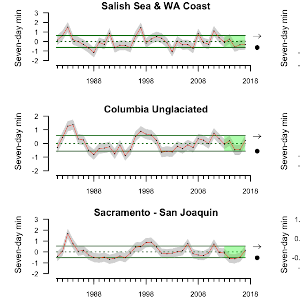This document is a companion to the ecosystem status report (ESR) provided by the California Current Integrated Ecosystem Assessment team (CCIEA team) to the Pacific Fishery
Management Council (PFMC) in March of 2018 (Harvey et al. 2018). The CCIEA team provides ESRs annually to PFMC, as one component of the overall CCIEA goal of providing quantitative, integrative science tools, products, and synthesis in support of a more holistic (ecosystem-based) approach to managing marine resources in the California Current.
This report presents indicators codeveloped by the CCIEA team and PFMC beginning in 2009.
The indicators have been refined and updated over the years to best capture the current state of the California Current ecosystem. The analyses in this document thus represent our best understanding of environmental, ecological, and socioeconomic conditions in this ecosystem roughly through 2017. Because the time required to process the data from different indicators can vary, some of the resulting time series are slightly more up-to-date than others. Some indicators (snowpack, fishery landings, and revenue) have been updated since the March 2018 report to PFMC (Harvey et al. 2018).
In terms of the natural biophysical system, we regarded 2017 as a transitional year, in which the CCE continued its recovery from the marine heat wave of 2013–16 and the major El Niño event of 2015–16. We similarly considered much of 2016 to be transitional. By “transitional,” we mean that many indicators suggest that the system has shifted away from the highly unusual conditions of the marine heat wave and El Niño events, which included very warm water temperatures, weaker-than-normal southward-flowing currents along the U. S. West Coast, and widespread occurrence of species normally associated with warmer southerly and/or offshore waters (including the pyrosomes featured on the cover of this report). However, aspects of these conditions remain in patches throughout the system, and we do not feel confident that the system has returned to a more typical regime (e.g., the relatively cool and productive periods or warm and unproductive periods governed by climate and oceanography patterns that have been observed for much of the past century).
Moreover, some populations of protected species and others targeted by fisheries may show the effects of the unusual warming events at lag times of months to years, even after physical conditions and characteristics of the base of the food web have returned to average or above-average conditions.
Among the indicators that suggested a return to more typical conditions in the CCE:
• Indicators of temperature and circulation in the North Pacific Ocean and along the U.S. West Coast were closer to long-term averages for much of 2017.
• Some important forage fishes, squids, and krill increased in abundance in the central and southern regions of the system.
• Pup growth of California sea lions (Zalophus californianus) at the San Miguel Island colony was normal, implying improved feeding conditions for adult female sea lions in that region.
• Unlike many recent years, no mass seabird die-offs that could be attributed to poor food availability were recorded in 2017.
Other indicators, however, revealed that the CCE in 2017 was still experiencing residual effects of the recent atypical period:
• Warmer-than-normal water masses persisted into 2017, particularly in deeper waters in the northern CCE.
• Although the community of copepods (tiny free-swimming crustaceans at the bottom of the food web) off of Newport, Oregon, experienced a greater occurrence of cool-water,
energy-rich species in certain sampling periods, there remained a large number of species associated with southerly or offshore water masses.
• Pyrosomes, free-swimming colonial gelatinous animals (see cover photo) that prefer warmer waters normally found further to the south, were extremely abundant in the
northern and central CCE.
• Juvenile salmon catches were poor, and other indicators projected below-average Chinook (Oncorhynchus tshawytscha) and coho (O. kisutch) salmon returns to the Columbia River
basin in 2018.
• Reports of whale entanglements in fixed fishing gear were above-average for the fourth consecutive year, possibly as a result of changes in the timing and location of food
availability for the whales.
Many indicators of fishery landings and revenue have increased since a recent low point in 2015, with increases mainly attributable to Pacific hake (Merluccius productus), market squid (Doryteuthis opalescens), and Dungeness crab (Metacarcinus magister). Conversely, recreational fishery landings have been declining since 2015. We continued to observe a decline in the diversification of catch revenues by commercial fishing vessels of all size and revenue classes in all three coastal states; in other words, on average, vessels are relying on steadily fewer species to provide the bulk of their revenues. We are working to understand how the reliance of coastal communities on commercial and recreational fishing relates to those communities’ overall social wellbeing and vulnerability.
The sections that follow will go into greater detail about the status and trends of indicators summarized here; we include sections related to Climate and Ocean Drivers, the Focal Components of Ecological Integrity, Human Activities, and Human Wellbeing, followed by a brief Synthesis.


